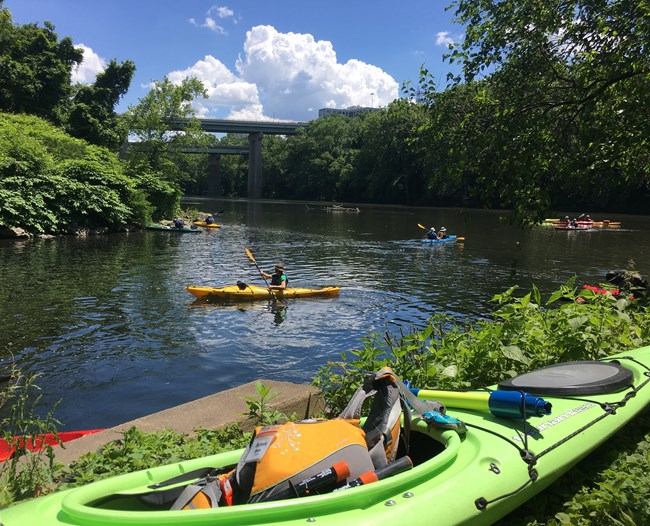Since then, over 4000 canoers and kayakers have convened on the Schuylkill River for an annual celebration of the watershed and its communities, renewing a sense of regional unity and stewardship on which it was built.
Article
The Schuylkill River Sojourn: Fostering Environmental Stewardship and Community

Schuylkill River National Heritage Area
In early June, 2017, the Schuylkill River Heritage Area hosted its 19th annual Schuylkill River Sojourn. Organized around the theme “I Protect the Schuylkill River,” this year’s Sojourn drew 220 paddlers from 12 states, 70 of which completed the entire 112-mile journey from Schuylkill Haven to Philadelphia’s Boathouse Row. Throughout the Sojourn, paddlers experience noon and evening programs aligned with the watershed preservation theme at stops in historic river towns, trailheads and riverfront parks along the Schuylkill River Trail.
The Schuylkill River Heritage Area is a state and national heritage area (NHA) managed by the Schuylkill River Greenway Association(SRGA) which connects five counties and four National Park Service (NPS) park sites along the river: Hopewell Furnace National Historic Site, Valley Forge National Historical Park and Independence National Historical Park. The NPS has provided support and assistance since before the area was designated as a national heritage area.
This year’s theme is a nod to the longstanding mission of the heritage area to connect and preserve the Schuylkill River while promoting environmental stewardship. The SRGA has been focused on environmental restoration and encouraging recreation since its formation in 1974, and serves as the management entity of the NHA. In 1999, the SRGA founded the Sojourn in response to the Schuylkill River’s designation as River of the Year by the PA Department of Conservation and Natural Resources, which remains a managing partner.

Miriam Akervall
Throughout the week, programs covered topics such as: the effect of water quality on bird species and habitat; landscaping practices that protect rivers and streams; or outlining current initiatives by organizations such as the Philadelphia Water Department and the Schuylkill Action Network (SAN) to approach the challenges facing the river. SAN also sponsored this year’s Sojourn Steward who engaged in regular water quality monitoring during the trip and wrote a blog along the way.
Alongside educational programming, paddlers also enjoyed musical performances, locally catered meals, and campfires when the weather allows. “Heritage areas build emotional investment,” says Executive Director of Schuylkill NHA Elaine Paul Schaefer. “Instead of giving people the parade of horribles if they don’t protect the river, [we] invite them to enjoy it and participate… All of a sudden they become ambassadors.”
Although often described by Sojourners as a “staycation,” for many paddlers, the sojourn is much more than that. Over the years, the group has become a community of its own. Each day of the Sojourn, around 100 paddlers take to the water trail to reconnect with the landscape as well as old friends.
“It’s like going to summer camp,” says Carl Raring, a phrase well worn by the Sojourn’s many regulars. Raring is one of two people to have paddled all nineteen summers; he and Jim Showalter met “in the first hour of the first day” at the inaugural Sojourn in 1999. Although they kayak together outside of the Sojourn, the first week in June symbolizes the beginning of nearly two decades of friendship, and an opportunity for a reunion with those they’ve met over the years.
“The camaraderie of the people that you meet here is one of the greatest things about the Sojourn,” adds David Kohler, who has pitched his tent near Raring and Showalter. “I’ve only been on 18,” he says and laughs as they tease him.
For Sojourners based in the area, like Jay Kudach, the appeal of the Sojourn is that it offers a fresh perspective on a familiar landscape. “I live ten minutes away from [the Schuylkill River] and I rarely see this side of it,” he says, “we camp out in these little neighborhood places you wouldn’t normally get to otherwise.” It is only Kudach’s second year on the Sojourn, and he already has plans to return in 2018.
According to Laura Catalano, Communications Director of the Schuylkill NHA, about three-quarters of the 2017 participants are returning Sojourners. Many become involved in watershed protection organizations in their own communities, spreading stewardship values to friends and loved ones. Raring agrees: “Our daughters have been veterans of many Sojourns as well,” he says, referring to his own and Showalter’s. Being on the river, establishing meaningful connections with the landscape as well as the people motivates Sojourners to care for this resource, leading by example to encourage the next generation to do the same.
Last updated: September 4, 2024
